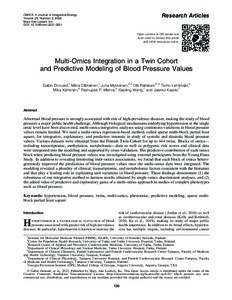Multi-Omics Integration in a Twin Cohort and Predictive Modeling of Blood Pressure Values
Mykkänen Juha; Wang Xiaoling L; Mishra Pashupati P; Raitakari Olli; Ollikainen Miina; Drouard Gabin; Kähönen Mika; Kaprio Jaakko; Lehtimaki Terho
Multi-Omics Integration in a Twin Cohort and Predictive Modeling of Blood Pressure Values
Mykkänen Juha
Wang Xiaoling L
Mishra Pashupati P
Raitakari Olli
Ollikainen Miina
Drouard Gabin
Kähönen Mika
Kaprio Jaakko
Lehtimaki Terho
MARY ANN LIEBERT, INC
Julkaisun pysyvä osoite on:
https://urn.fi/URN:NBN:fi-fe2022081154669
https://urn.fi/URN:NBN:fi-fe2022081154669
Tiivistelmä
Abnormal blood pressure is strongly associated with risk of high-prevalence diseases, making the study of blood pressure a major public health challenge. Although biological mechanisms underlying hypertension at the single omic level have been discovered, multi-omics integrative analyses using continuous variations in blood pressure values remain limited. We used a multi-omics regression-based method, called sparse multi-block partial least square, for integrative, explanatory, and predictive interests in study of systolic and diastolic blood pressure values. Various datasets were obtained from the Finnish Twin Cohort for up to 444 twins. Blocks of omics-including transcriptomic, methylation, metabolomic-data as well as polygenic risk scores and clinical data were integrated into the modeling and supported by cross-validation. The predictive contribution of each omics block when predicting blood pressure values was investigated using external participants from the Young Finns Study. In addition to revealing interesting inter-omics associations, we found that each block of omics heterogeneously improved the predictions of blood pressure values once the multi-omics data were integrated. The modeling revealed a plurality of clinical, transcriptomic, and metabolomic factors consistent with the literature and that play a leading role in explaining unit variations in blood pressure. These findings demonstrate (1) the robustness of our integrative method to harness results obtained by single omics discriminant analyses, and (2) the added value of predictive and exploratory gains of a multi-omics approach in studies of complex phenotypes such as blood pressure.
Kokoelmat
- Rinnakkaistallenteet [19218]
